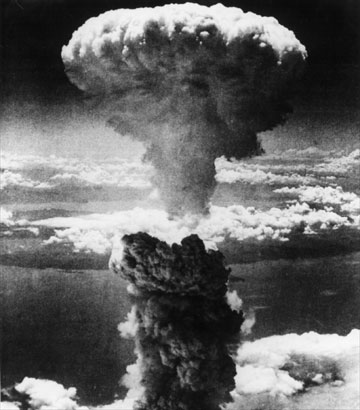"That's the price you pay for our protection." - A high-ranking US official referring to the rape of a 12-year-old Okinawan girl by three American soldiers.
from Los Angeles Times
"Why are we here? No. 1, the defense of Japan. No. 2, the defense and security of the region." - A blatant lie by Rear Adm. James Kelly

Yokosuka, Japan -- As Masahiko Goto sees it, the U.S. aircraft carrier George Washington is not a ship. It's a floating nuclear disaster waiting to happen near one of the world's biggest cities.
Its recent deployment to a port near Tokyo was welcomed by brass bands, an open-house crowd of 30,000 and promises of greater security for Japan and the region. But to opponents here, it all boils down to two nuclear reactors and one big question: Are they safe?
"It is unthinkable that we have reactors floating in the bay," said Goto, a lawyer who is leading an effort to have the ship banned from Japan. "If there was a problem, it would affect not just our city, but Tokyo and the heart of Japan."
The George Washington is the first and only U.S. nuclear-powered warship with a home port outside the United States, and Japan -- the only country ever attacked with nuclear weapons -- has special sensitivities about anything nuclear.
"That word just sets off all kinds of bells and whistles here," said Rear Adm. James Kelly, commander of U.S. Naval Forces, Japan. "But just because you're using the 'R' word -- the radiation word -- doesn't mean it's bad."

Two recent incidents have raised concern.
The ship's arrival in September was delayed after a fire broke out in its lower decks May 22 while it was docked in the U.S. for repairs. It took nearly eight hours to find the source of the flames, by which time the fire had burned through eight decks and damaged 80 compartments.
The blaze was blamed on improper storage of hazardous materials, unauthorized smoking and other missteps. The Navy estimates the damage from the fire at $70 million. The reactors were unaffected and there was reportedly no danger of a radiation leak.
But a month earlier, information emerged that the U.S. submarine Houston had leaked radiation during visits to two Japanese ports, provoking headlines and a formal Japanese government protest.
Goto and others, who are pushing a referendum on whether Japan should host nuclear-powered vessels, say these incidents undermine the Navy's assertion that the George Washington is safe.
Capt. J.R. Haley, who took over as commanding officer of the carrier as part of a sweeping disciplinary action after the fire, says safety procedures have been tightened.
As for the Houston, the Navy disclosed that the submarine had leaked during stops at Sasebo and Okinawa between 2006 and 2008. It said the problem was discovered in July, when the vessel was in dry dock. A Navy report said about a gallon of water spilled on a crew member July 17 when a fitting came loose.
The report said that no similar leakage had occurred in the last 50 years, and that the amounts were extremely small and posed no health risks.
"The Houston was a very minor issue," said Rear Adm. Michael Connor, commander of Submarine Group Seven, which operates around Japan. "It was a small issue that plays out because it has the word 'nuclear' in it."
Connor said that the Navy wasn't required to disclose such small leakage but did so to gain trust. "We've told the government of Japan that we are going to tell them about every little thing," he said.
He rejected Goto's worst-case scenarios, saying the vessels' reactors are much smaller and tougher than commercial ones, and generate much less power. "There is no comparison," he said.
Port visits by nuclear-powered warships are banned by some countries, but not Japan. Since 1964, such ships -- mostly submarines -- have visited Japanese ports more than 1,200 times, Navy records show.
Kelly said nuclear-powered carriers are newer, faster, have greater range and don't carry millions of barrels of diesel fuel, meaning the risk of oil spills is much lower.
The Navy says a U.S. carrier is needed, and no nonnuclear one is available. The last conventionally powered carrier, the now-decommissioned Kitty Hawk, was replaced by the George Washington.
"Why are we here? No. 1, the defense of Japan. No. 2, the defense and security of the region," Kelly said.
"A carrier has got to be out here, clearly."

No comments:
Post a Comment